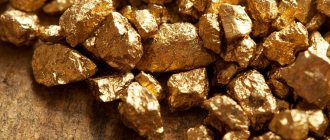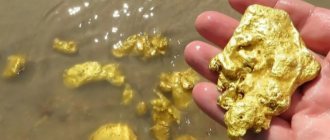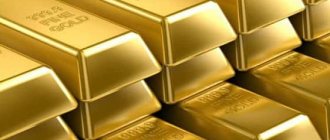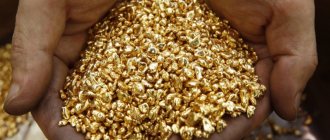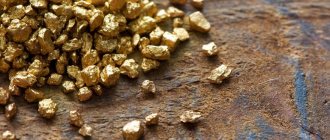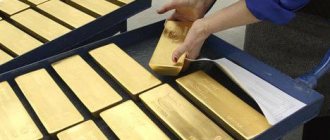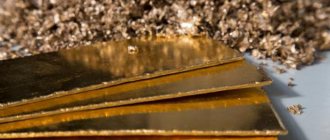The Russian Federation has been actively mining gold since the early 19th century. We use our own wealth to replenish our gold reserves and continue the industrial production of various products from precious metals. It was in the 19th century that currency circulation included minted gold coins, which today have turned into souvenir jewelry. Therefore, the “yellow breed” is of strategic importance for the Russian economy and the economies of other countries.
Today Russia ranks third in terms of gold production. China is in first place, Australia in second. Every year, reserves of valuable metals are replenished by 250 tons, which has a positive effect on the economic situation. If we take into account the information of geologists, our country contains more than 380 primary and about 5,100 alluvial sites where gold mining . Some of them are included in the reserve, the rest are already actively used.
In this article we propose to talk about how and where gold mining occurs in Russia , what methods of extracting the “yellow metal” from the bowels of the earth are known. Let's get started!
What is gold and what is its value to humans?
This is an element of the eleventh group of the sixth period of periodic chemical elements, occupying position 79 (Au - aurum). Gold is a noble metal that has high density, thermal conductivity and low resistance to electricity. Despite its good density, the hardness of the material is barely comparable to a human fingernail. But it is impossible to destroy it with the help of acids and alkalis, and therefore aurum is considered a noble metal.
According to statistics, only 10% of the total volume of gold mining is used in industrial activities. The remaining 90% found a place in the creation of jewelry, and therefore are used in the form of gold and foreign exchange reserves.
The largest nuggets in the history of Russia
Over the two-hundred-year history of gold mining in Russia, several large native formations have been found:
- 1842, Ural: “Big Triangle” (weight 36 kg);
- 1936, Chelyabinsk region: “Bolshoy Tyelginsky” (14 kg);
- 1961, Magadan region: “Golden Giant” (14 kg).
The largest gold nuggets
Classification of gold deposits
There are 2 types of locations:
- indigenous;
- placer.
Indigenous, also known as primary deposits, are part of the magma ejected to the surface of the earth. Often golden metals are found in the form of nuggets. But there are pieces fused with other elements of the periodic table: copper, quartz, iron, sulfur. Just a larger percentage of mined minerals are located in primary places.
Placer (secondary) places where precious metals appear are formed during the destruction of primary deposits. These can be air currents, exposure to water, temperature changes, and even the results of bacterial activity. Until the end of the 19th century and the beginning of the 20th century, valuable rocks from placer formations were purified by grinding. Light alloys were washed with water, and the remains were melted into ingots.
Alternative methods of extracting gold from old equipment
Gold is used for various purposes, one of the areas is the production of parts. The precious metal can be restored when equipment fails. But you can’t throw it away; you should remove the products.
Reception of raw materials
It is difficult to sell spare parts from a phone and other electronics on your own, so the more common method is to hand over devices to special points. To determine the authenticity of Au, chlorine and iodine are used at home. In a day you can remove enough circuit boards from non-working electrical appliances and gadgets, and then find an electronics collection point in the Moscow region, Moscow or another region or city in Russia.
Each board contains several milligrams of gold; according to the observations of specialists and radio amateurs, more precious metal is found in old equipment.
Chip etching technology
Craftsmen disassemble electronics and remove microcircuits. They will need to be soaked, for which a solution of hydrochloric acid and hydrogen peroxide (2:1) is prepared. Etching takes 1 week. Towards the end of this period, you can see separated yellow scales. They are quickly collected through a coffee filter and washed using alcohol. Then they melt it down (you will need a transformer).
Geography of gold mining in the Russian Federation
In each country, mining sites are constantly changing. Just a few decades ago, 50% of efforts were concentrated in the Republic of South Africa. However, after 10 years, the percentage decreased to 30. This was due to the fact that other countries also began to explore their own territories, not only finding new places, but also improving production technologies in order to increase volumes. Among such countries are Brazil, the Philippines, and Uruguay. At the moment, China has become the leader in gold mining, as mentioned above. About 350 - 400 tons per year are found there every year.
However, not only China, but also other countries can boast of good results in the gold mining industry. To understand where the greatest gold mining efforts are concentrated, let's look at the map. Mining locations are located in close proximity to the surface of the earth. Among the areas actively working in the field of gold mining are the following:
- Amurskaya;
- Irkutsk;
- Krasnoyarsk;
- Magadan;
- Republics of Buryatia and Sakha;
- Sverdlovskaya;
- Khabarovsk region.
However, a larger percentage of the gold mining industry is devoted to the Urals. The largest gold deposits in Russia are located there. Mother Nature herself ordered that “yellow metal” be formed in the Urals, creating moderate climatic conditions for this. In addition, this location boasts optimal infrastructure, which allows you to get to mining sites without much effort.
To clearly show the volumes in tons over the past years, we recommend taking a look at the table below.
| Year | 2015 | 2016 | 2017 | 2018 | 2019 |
| Dobychnoe | 232,60 | 234,25 | 237,84 | 254 | 264,42 |
| Along the way | 16,79 | 16,98 | 15,33 | 16,5 | 15,45 |
| Secondary | 38,55 | 38,27 | 35,41 | 36,7 | 34,58 |
| Total | 287,94 | 289,50 | 288,58 | 307,2 | 314,45 |
Countries leading gold consumption in the world
Speaking about gold consumption, we are primarily talking about the use of gold in the jewelry industry (70-80% of total consumption), as well as its use in electronics, medicine and other industries. Thus, the leaders in consumption at the end of 2021 were:
- China - 785.2 t
- India - 700.5 t
- USA - 156 t
- Japan - 99.9 t
- Türkiye - 98.4 t
- Italy - 83.6 t
- South Korea - 80.9 t
- South Africa - 70.7 t
- Iran - 62.8 t
- Indonesia - 49.1 t
In total, 2816.5 tons of gold were used in the world in 2021. Moreover, the most active demand for gold consumption comes from the countries of the Asian region. Russia's consumption at the end of 2021 amounted to 47.4 tons , it took 11th place right after Indonesia.
You can see the full statistics of gold consumption by country in the table below under the spoiler:
Expand the table of gold consumption in countries around the world
| A country | Gold consumption, t |
| The whole world | 2816.5 |
| China | 785.2 |
| India | 700.5 |
| USA | 156 |
| Japan | 99.9 |
| Türkiye | 98.4 |
| Italy | 83.6 |
| South Korea | 80.9 |
| South Africa | 70.7 |
| Iran | 62.8 |
| Indonesia | 49.1 |
| Russia | 47.4 |
| Germany | 43.7 |
| UAE | 42.7 |
| Switzerland | 35.7 |
| Saudi Arabia | 34.4 |
| Malaysia | 30.1 |
| Singapore | 28.2 |
| Canada | 25 |
| Thailand | 24.7 |
| Egypt | 24.5 |
| Taiwan | 23.9 |
| Brazil | 23.8 |
| Great Britain | 21.4 |
| Vietnam | 20 |
| Pakistan | 17.9 |
| Australia | 12.7 |
| Austria | 12.5 |
| Kuwait | 11.8 |
| Jordan | 11.4 |
| Sri Lanka | 9.8 |
| Mexico | 9.6 |
| Uzbekistan | 8.3 |
| Lebanon | 8.1 |
| France | 6.8 |
| Morocco | 6.3 |
| Kazakhstan | 6 |
| Bahrain | 5.6 |
| Spain | 5.3 |
| Israel | 5.1 |
| Greece | 3.9 |
| Iraq | 3.6 |
| Oman | 3.2 |
| Myanmar | 3 |
| Poland | 2.8 |
| Libya | 2.8 |
| Nepal | 2.6 |
| Chile | 2.5 |
| Philippines | 2.4 |
| Netherlands | 2.2 |
| Costa Rica | 1.8 |
| Hong Kong | 1.8 |
| Qatar | 1.8 |
| Portugal | 1.5 |
| Bangladesh | 1.5 |
| Czech | 1.1 |
| Belgium | 0.8 |
| Luxembourg | 0.2 |
| Finland | 0.1 |
Extraction methods
For a long period of time, starting from the end of World War II, new technologies have been regularly developed that make it possible to mine gold in large volumes and at minimal cost. Before this, rather primitive methods were used, which today are called traditional.
Today, improved methods of gold mining . We owe this to scientific progress. To increase production volumes, special equipment is used to work on a large scale.
It has become easier to mine precious metals, because modern industry offers 3 methods of gold mining:
- career;
- mine;
- draggy.
The first method is characterized by large open areas. To do this, areas are either excavated using specialized equipment or undermined. The second method is most often used. Then, with the help of machines with human participation, aurum is obtained.
Since most of the “yellow metal” is concentrated in the bowels of the earth, it is often mined in mines. Basically, people take part here, since not every mine is capable of accommodating equipment. For mining using the shaft method, you will need a drill, the length of which can reach several hundred meters. After this, elevators are installed to move people and carts. And finally, precious metals are mined.
The third method is usually classified as a separate category, since it is characterized not only by the harvesting of minerals, but also by their enrichment. Dredge mining is determined by the use of a floating mining and processing machine. And dredges are popular only in placer deposits.
Most often, in the dredging type of gold mining, pit opening is used. Its essence lies in the formation of an underwater section. At the same time, the volume of water must be quite large so that the unit can be installed in any location, extracting precious metals without hindrance.
In addition to pit opening, other methods of gold mining are known:
- dam;
- transshipment;
- inferior.
They are often combined if the scattering is unevenly distributed. However, any of the above methods negatively affects bodies of water: rivers, lakes, seas.
Our days.
0
During the reign of L.I. Brezhnev, gold mining in Russia was not going through the best period; the industry did not receive due attention. A large amount of precious metal reserves went to foreign markets for the purchase of food, while the level of production invariably fell. In 1988, the approach to supplying the industry was revised, reorganization took place, and production levels began to increase. In 1990, it reached a respectable level of 300 tons. The perestroika period was chaotic for the entire economy, including the gold mining industry. Metal sales on foreign markets grew despite a sharp drop in output. The most critical year was 1998, production amounted to only 115 tons. With government intervention in fishing, the situation began to level out, but a unified system has not yet been developed. Gold is an important financial component of GDP, but there is no unified policy yet. At the beginning of the 21st century, there are almost 6 thousand deposits in Russia.
8.
Extraction Methods
As mentioned above, aurum is often fused with other chemical elements in the depths of the earth. Therefore, it must be separated by selecting pure gold. Specialized technology, as well as advances in the chemical industry, have achieved considerable success in this. Moreover, the process of separating particles of “yellow metal” has become almost automated.
Among the main selection methods are known:
- almagalming;
- sodium cyanide leaching;
- flotation.
Despite the complicated name of the first method, if you know the basics of chemistry, you can definitely do the same steps. The essence of almagalming is the use of ordinary mercury. After all, she can attract gold. The course of action takes place in several steps:
- Mercury and rocks are placed in the tank, after which they are shaken.
- Mercury attracts gold and settles at the bottom of a special container.
- The container is heated and the precious metal is separated from the mercury.
This method was quite common due to its practicality and low cost. But today it is not recommended to use it, since mercury has a detrimental effect on the human body.
Leaching with sodium cyanide is an equally popular method. To begin with, the previously mined rock is ground to the smallest particles. Then add sodium cyanide and shake the container well. Unnecessary liquid is released, and solid particles of rock settle to the bottom.
Flotation is not much different from leaching. The rock is also crushed, and then filled with water and oil, after which it is mixed. The liquid remains on the surface, and the metal settles at the bottom.
Techniques for clearing the “wheat from the chaff”
To improve the quality of a precious metal, one of the following techniques is used:
- leaching is a method based on the extraction of Au from complex compounds, for example, if iron sulfide minerals are present, it is necessary to heat the working medium to a certain temperature and increase the pressure (autoclaving method), impurities will be removed, and gold with this method of extraction and purification will become a solid residue ;
- electrolysis - the method is used provided that the alloy contains no more than 5% Ag impurities, when electrolysis is used, gold is dissolved, for which certain types of acids are prepared (most often hydrochloric), then the precious metal enters a special chamber, and the impurities go into another compartment;
- amalgatation - the method is based on the use of mercury, which absorbs Au particles; when their amount in the liquid metal becomes extremely high, separation occurs, which allows the precious metal to be collected, separating it from the mercury as well;
- Water washing is a method used when gold is mixed with lighter minerals.
How to extract aurum legally?
Is it possible to mine this mineral yourself? This question interests young enterprising people who want to realize their dreams by mining precious metals. Until 2021, independent mining was prohibited. However, the government of the Russian Federation soon decided that this was an excellent chance for the development of small businesses. According to smaller estimates, gold mining by entrepreneurs will bring at least 300 kg of “yellow metal” per year to the gold reserve. It is worth noting that at first the law on the possibility of gold mining applied only to Chukotka, Yakutia, Krasnoyarsk Territory, Altai and the Far East. Then it spread throughout Russia.
According to current legislation, persons registered as individual entrepreneurs can engage in the extraction of valuable metals. However, there is a list of restrictions. Individual entrepreneurs cannot hire other people interested in finding precious metals. All actions must be carried out manually, that is, using metal detectors, hand dredges, and washing trays. The use of specialized equipment is strictly prohibited.
Today we found out by what methods the 79th element of the periodic table of chemical elements is obtained. We talked about where aurum is mined and how the extraction is classified. We examined methods for separating valuable metal and answered the question of whether it is possible to engage in such activities on our own. We hope the article was interesting and informative. See you again!
The legend of the find.
0
The history of gold mining in Russia, according to the official version, began in the 18th century. It is believed that the start was a small pebble found by a schismatic in the area of present-day Yekaterinburg. For some reason, he reported the find to the administration of the Yekaterinburg plant. He continued his search and discovered many such stones. Later, the “Primary” gold mine was founded on the site of the finds. The fact that gold mining in Russia could become a large-scale industry has been mentioned since the fifth century. This was reported by many historians who visited the regions of the Ural mountain system and observed among the indigenous peoples a large amount of jewelry and household items made from precious metal. The foundation of the industry on a national scale was laid by Peter the Great in 1719. At the beginning of the 19th century, Russia became a leader in the development and production of gold. After the reform carried out by S. Yu. Witte and the introduction of the “gold standard”, gold coins began to be minted in Russia, and mines became available for development by foreign companies and private individuals.
×
3.

